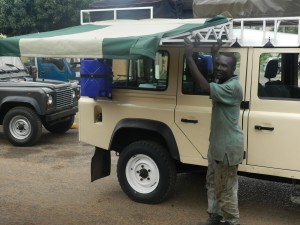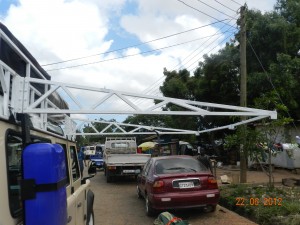Like all our outfitting needs, the challenge in Ghana  is where do we get it from? There is no shortage of manufactured RV/4×4 awnings in the market, but not in the market in Ghana. We knew we were taking a shopping trip to South Africa to buy outfitting gear (see separate March 2012 post “A Shopping Spree Like no Other” www.overlandrover-westafrica.net/?m=201203) and there are a great number of manufactured options available, including a couple from Eezi-Awn, the South African manufacturer that makes the rooftop tent that we are buying.  The problem with these is that outfitters tend to be bulky and heavy, do we really want another 20 kilos hanging off one side of the roof? We also need to make choices to keep shipping, and purchase, costs down.  The manufactured awnings are all rather expensive, seem to start about CAD 500 and go up from there.
I have a better idea. Instead of going for one of the manufactured awnings I have designed one to fit our roof rack and am getting Paani the welder, who has now done more work on the Landy than any other single person with the possible exception of Opere the mechanic, to put it together. It was Paani who rebuilt the doors and the original body work and a number of things around the body.
My awning design is based on the existing roof rack, which is built of metal 1″ square. The carrier rests on 12 of these 1″ square vertical “posts” that sit in the gutter that runs long the side of the roof above the windows.  I encouraged Paani to use the same 1″ square metal to design and build two flat right-angle triangles 6″ high x 5′ long.  The catalogue of Lee Valley Tools in Ottawa Canada was the source for quality stainless steel 1″ piano hinge used to fasten these two triangles to two of the upright posts in the roof rack, 6’ apart.   The triangles swing out from the carrier to right angles with the Landy and are held apart with a 6′ long bar, also created by Paani, mounted on the ends to form a square.   A piece of canvas fitted with grommets then stretches over nipples on the top of the frame to make a tight, sloping 5’x6′ awning. To collapse it, the canvas comes off and goes in a bag and the triangle supports fold in flat against the roof rack. The end bar slips into long space beside the drawers on the cargo bay floor and the bag with the canvas gets thrown anywhere in the back.  That is the basic design, there are a couple of  subtle refinements that make it work. There is a 1″ thick piece added to one of the uprights so that the triangles fastened to it can hinge so it folds flat over the other triangle to close.  A piece of velcro wraps around the triangles to keeps them tight against the side of the roof rack. If I may say so myself, it is a brilliant design, unfortunately there is not enough market to make it worth going into production.

Paani with his finished product, complete with canvas bought in SA and tailored by Laura. The canvas comes down over the triangle but is folded up here to illustrate the structure.
The final cost turned out to be less than CAD 350, including Paani’s great work ($200), material for metal triangles and fittings($70), the canvas and tailor ($60), the grommets ($10) even the hinges ($10).   This compares very well to the cost of any of the manufactured options. The small Eezi-Awn option lists on-line at $700, which of course does include the shipping to get it to Ghana. Another important point of comparison is the weight.   The advertised weight of the small Eezi-Awn awning is 30 lbs (14 kgs), all the pieces of ours add up to 19 lbs (9kg).  And best of all, and perhaps somewhat surprisingly, it works very well. Using the grommets it fits snugly over the frame and there is no perceptible sag.  It takes longer to set up and take down than a retractable awning but it is still pretty easy, and there are no moving parts to fail.
There were 4′ of the Lee Valley piano hinges left from the 6′ piece I bought, I left this with Paani so he can build, and sell, a couple more in response to the interest expressed by other Landy owners who have seen ours when they are visiting the shop.

